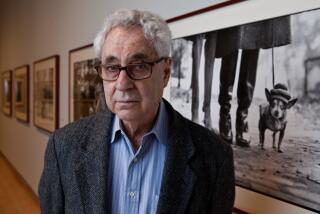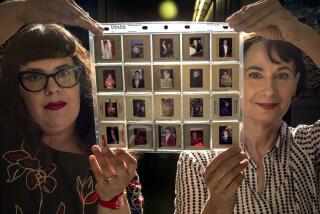Another side of Ansel Adams
- Share via
After last year’s controversy over Rick Norsigian’s hotly disputed claim that he had unearthed a trove of “lost” 1920s negatives of Yosemite and coastal California by Ansel Adams, the photography world might be expected to greet any further surfacing of “lost” pictures by the great nature photographer with appropriate skepticism.
But for its current exhibition of 29 virtually unknown pictures by Adams and his dear friend and mentor, Cedric Wright, the Chadwick School on the Palos Verdes Peninsula seems to have a great deal of the ironclad documentation Norsigian lacked.
Thirteen images come from 1941, when Chadwick School hired Adams to produce its fifth-anniversary promotional catalog, and 1942, when he returned to shoot a tennis exhibition at the private school’s hilltop campus. Also on display are pictures of Chadwick taken in the late 1940s by Wright.
The photos, on display through Friday at the Palos Verdes Library’s Peninsula Center building in conjunction with Chadwick’s 75th anniversary, find Adams far from the mountains and deserts where he made his name. A key picture, used as the catalog’s center spread, shows that he could capture fleeting human gestures along with the eternal grandeur of nature: A pretty teenage girl strikes what appears to be an unplanned, momentary glamour pose, facing the camera and reaching for her dark, wavy hair while three classmates stroll along the strand at Abalone Cove.
Lending poignancy to the shot, says Lance Bowling, one of the show’s organizers, is the knowledge that this was taken during the late winter of 1941; by year’s end, America was at war, and Abalone Cove was soon to be cordoned off for military purposes. “He captured this pristine place, at the last moment before life changed,” said Bowling.
Among the 30 pictures in the catalog are Adams’ depictions of student life — including a boy whacking a baseball and teens immersed in their books, as well as pictures of the school’s landscapes and gardens.
In his autobiography, Adams describes Wright, an accomplished violinist who was 14 years his elder, as “my best friend for many years,” starting with a 1923 Sierra Club trip in which they bonded over their mutual love of music, the mountains and “our budding awareness of photography.”
“Perhaps his greatest gift was imparting confidence to those who were wavering on the edge of fear and indecision; often it was me,” Adams wrote. According to Adams biographer Mary Street Alinder, Wright’s coaxing helped Adams get up the nerve to propose to his wife in 1927.
Wright also figures in the Halloween, 1941 creation of “Moonrise, Hernandez, New Mexico, 1941,” considered perhaps the greatest picture Adams ever took. According to Alinder, Wright and Adams’ 8-year-old son, Michael, were his companions on the autumn road trip that took them into the desert; when Adams saw the sky doing amazing things that late afternoon, she writes, he whipped Wright and his son into action to help him get his camera and tripod set up in time to capture the image.
In the Chadwick exhibition, it’s Wright who trumps Adams with the show’s most jaw-dropping image: a 1947 shot of five boys playing basketball on the school’s outdoor court, against a backdrop of rolling hills and the Los Angeles Basin far below. It captures a moment of sheer ballet, the composition so gracefully perfect that one would think it had been choreographed by Balanchine — except that you can’t choreograph players leaping for a rebound.
“We just love this picture,” said Mary Baldovin, Chadwick’s chief fundraiser, who helped organize the exhibition. “I could just look at it all day.”
More to Read
The biggest entertainment stories
Get our big stories about Hollywood, film, television, music, arts, culture and more right in your inbox as soon as they publish.
You may occasionally receive promotional content from the Los Angeles Times.











